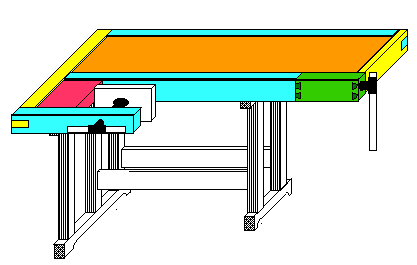Finally, A Real Work Bench
(I'm going to try and document designing and building my workbench, from how the design was developed, how it was built, what problems were encountered and how they were solved (or hidden or better yet, made into a "feature").
In ignorance, and on the advice of a cabinet maker friend, I made my current bench as big as would fit - 50" W x 88" long, one chinsee vise on the front left corner. Doubled up douglas fir 2x4s base with 2 layers of 1 1/8 ply and a 1/4" melamine top screwed down, pine 2x4 skirt it was great for layout and assembly but sucked if you wanted to do any neandering. So when I expanded into the other half of the four car garage this bench moved into the new "clean area", leaving room for a "real bench" in the "dust and wood chips area".
My initial design constraints and considerations are:
- the bench should be no taller than my saw table - 34 1/2" specifically
..(actually it's a Robland combination machine with a shaper and saw on one table and the jointer/planer
..next to that so the bench, due to its location, must not interfere with the "wood alleys" of the Robland)
- should be no wider than I can easily reach acrossed and perhaps no wider than a kitchen drawer is deep
- less than 6 feet long to leave enough room to walk around it easily without bumping into the equiptment
. which surrounds it
- as is always the case in a small shop, the bench should also have as much enclosed storage space as
.. possible
So, after going through all the images of all the workbenches I could find on the net, and having devoured the Scott Landis Workbench book and memorizing Sam Allen's Build A Workbench, I started doing some semi-scaled drawings of a cabinet maker bench. I'd decided on having a scandanavian front vise and a tail vise. Here's the basic set up though the proportions are off a bit. All the drawings were done in an old Mac program called Aldus SuperPaint and dropped into PhotoShop to convert to either JPEG or GIF files to use here.

Scored a maple bench top for $50, 3' x 6' x 1 3/4" thick. Rip it in half lengthwise (nice to have a sliding table) and have the option of having a 3 1/2" thick core for the benchtop.
Before going very far I took both sources books' advice and got the hardware before getting beyond initial planning. Good thing too - the "scandanavian" vice screw, while really beefy, is apparently 3+ inches longer than the ones in either book.
Doing a scaled drawing is almost a must for a project like this. Let's you see potential problems BEFORE you cut any wood AND gives you enough info to develop a pretty good materials list.